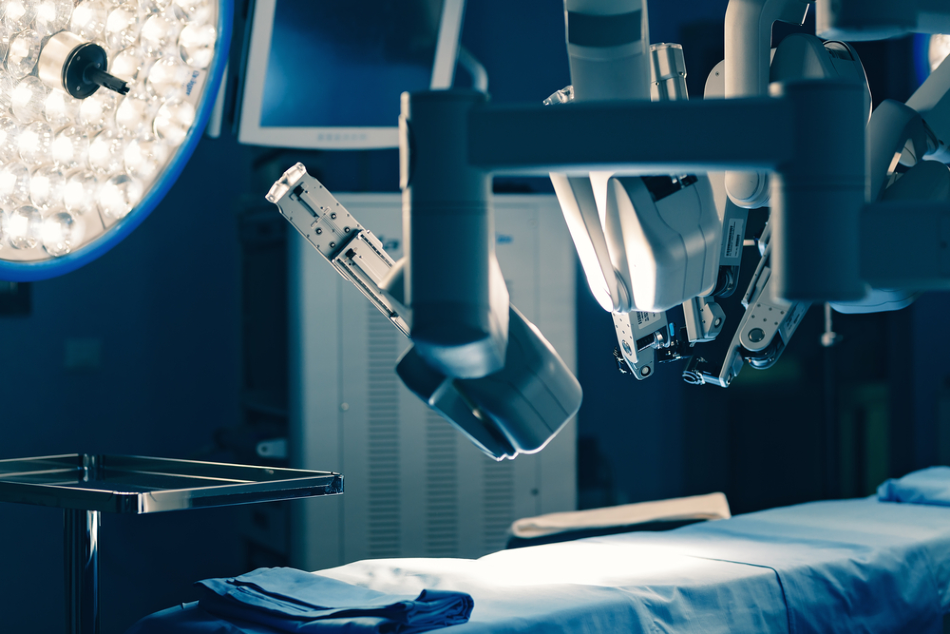Sep 21 2012

Image Credit: MAD.vertise/Shutterstock.com
Article updated on 24/02/20 by Stephen Edgar
Robotic systems in heath-care are finding more varied applications. Robotic devices have become ever more effective substitutes for replacing missing limbs. However, researchers have been working in parallel to develop robotic devices for use in surgical procedures, the delivery of rehabilitation to patients suffering from spinal cord injury and in their use as “companion bots” to help educate and support children with learning disabilities.
The development of surgical robots has matured to the point where they can be appropriately used in operating rooms. Technology - including telesurgery, such as the RP-VITA Robot designed to deliver healthcare at the lowest cost via audio-visual telecommunication for remote consultations – is shaping the healthcare environment. Perhaps the standard for robot-assisted surgery with more than 6 million surgeries globally, the Da Vinci has improved year on year but is still guided by a highly trained surgeon.
A more unusual development is the “snake robot” that could potentially be used to isolate tumors in the human body. The robot doesn’t work alone, a skilled surgeon helps guide the robot into intricate locations in the body where there may be a tumor. This paves the way for a minimally invasive surgical procedure that eliminates the need to cut through the patient’s soft tissue to isolate the surgical point.
This particular robot was developed by OC Robotics, specialists in the design and manufacture of snake-arm robots. The design and development of this device is in early trial stages and so the exact structural and functional principle are still to be refined. Some of the latest technology by OC Robotics for confined space is made of long flexible arms ideal for small openings.
Functional Components to the Snake-Arm Robot
The main components of the Snake-arm robot include:
An interface system that normally includes a PC with software to manipulate the Snake-arm and a controller to apply a multifunctional approach to the remote system.
The actuator is controlled using wires that feed electrical energy from the energy pack into the Snake-arm.
The main component of this robotic device that bridges the gap between the controller and the confined space is the Snake-arm. The structural components to this arm include links that give the arm the flexibility it requires to conduct automated operations. It is important that during surgical procedures the robot is light enough to limit any pressure on the confined space being operated on. During surgery, intricate confined spaces being operated on will be more sensitive to pressure and this also highlights the importance of creating medical robots that have a minimum mass for maximum reach without compromising the positioning of the robot and surrounding tissue.
OC Robotics - Snake-Arm Demonstrations
The speed of the OC Robotics Snake-arm tip is typically 1 m/s. The speed of any surgical robot will need to be matched to increased precision and repeatability.
The following video demonstrates the OC Robotics Snake-Arm and should give you an idea of how this machine work and how this technology is now being refined for wider application in surgical procedures where it will be used to isolate potentially hard-to-reach spaces and remove tissue.
How Do Surgical Robotics Work?
Technological advancements in snake robots are intricate and involve simulation techniques using sophisticated algorithms. The application of snake robotics to assist surgical procedures is an exciting and novel approach to healthcare. The concept of snake robots for keyhole surgery is becoming infectious among the application of sophisticated surgical operations.
The i2Snake Robotic Platform for Endoscopic Surgery is the evolution of the iSnake and has been improved to offer a platform that can perform more complex endoscopic surgical procedures such as ENT while reducing patient trauma and recovery time. The main feature of the intuitive i2-Snake robot is the imaging technology that provides the surgeon with increased flexibility to explore the confined surgical points within the human body. With a full range of articulated joints and motors along with sensors, this robot is a highly flexible sensing platform and allows for high precision and navigation.
The team behind this research are from the Hamlyn Centre at Imperial College London. The first generation iSnake robotics system has been taken through trials by being tested to perform surgical sterilization procedures. The key aim of this development is to provide sophisticated technology that eliminates the application of rigid instruments and to reform minimal invasive surgery.
In the following video, Professor Guang-Zhong Yang and Professor Lord Ara Darzi leading this innovative project offer insight into their research in developing the i-Snake surgical robotic device and emphasize the vision of hopefully seeing technology being used in hospitals.
Video Courtesy of the Welcome Trust
i-Snake® modular articulated design
Video Courtesy of the Hamlyn Centre
Benefits of Surgical Robotics
Research on the advancement of surgical robots demonstrates the synergy between imaging, sensory components, robots, and surgery, but what advantages does this technology offer? The application of snake-like surgical robots does mean that a more detailed investigation of the alimentary tract and heart surgery becomes possible. By eliminating the use of rigid surgical instruments that could potentially harm surrounding tissue there is the possibility of less invasive treatments and faster recovery time due to trauma-induced by limited access.
The main challenges ahead are focussed on join articulation, how to integrate an array of artificial sensor components and navigation methods into a surgical robotic system, and how this tool could be used to identify different tissues within the body.
References and Further Reading